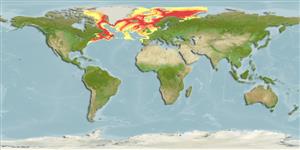Common names from other countries
Classification / Names / Names
Nombres comunes | Sinónimos | Catalog of Fishes (gen., sp.) | ITIS | CoL | WoRMS
Environment: milieu / climate zone / depth range / distribution range
Ecología
Pelágico; rango de profundidad 0 - 3000 m (Ref. 119523), usually 250 - 425 m (Ref. 117959). Polar
Distribución
Países | Áreas FAO | Ecosistemas | Ocurrencias, apariciones | Introducciones
Northern Atlantic and the Arctic: Svalbard and Canadian Arctic Archipelago.
Length at first maturity / Tamaño / Peso / Age
Maturity: Lm ? range ? - ? cm Max length : 1.8 cm TL macho / no sexado; (Ref. 130005); edad máxima reportada: 2.00 años (Ref. 130005)
Pelagic (Ref. 117453). Thousands of near-adult females were found swarming near-bottom (Ref. 117415).
Life cycle and mating behavior
Madurez | Reproducción | Puesta | Huevos | Fecundidad | Larva
Members of the order Amphipoda are gonochoric and sexually dimoprhic (males larger than females). Mating behavior: Males locate potential partners with the aid of their antenna to detect the pheromones released by the females; the male then rides or carries the female until the latter is ready to molt. When the female is ready, the male pushes the sperm into the marsupium and releases the female afterwards. A few hours later, the female releases her eggs into the marsupium for fertilization. Life cycle: Eggs are brooded in the marsupium. Eggs hatch into juveniles and remain in the marsupium for a few days. Each species undergo 20 molts at most, i.e., 1-year long life cycle.
Cusson, M., P. Archambault and A. Aitken. 2007. (Ref. 3448)
IUCN Red List Status (Ref. 130435)
CITES status (Ref. 108899)
Not Evaluated
Not Evaluated
Human uses
| FishSource |
Herramientas
Fuentes de Internet
Estimates based on models
Resiliencia
Alto, población duplicada en un tiempo mínimo inferior a 15 meses (tm<1; tmax=2).
Price category
Unknown.
